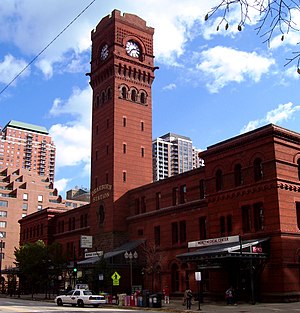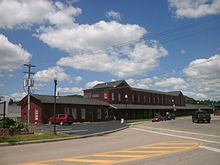User:Mitchazenia/Erie Railroad Main Line
| Main Line | |
|---|---|
 Dearborn Station, the western terminus of the Erie Railroad main line, now serving as commercial and retail spaces. | |
| Overview | |
| Locale | New Jersey, New York, Pennsylvania, Ohio, Indiana, Illinois |
| Termini |
|
| Service | |
| Type | Commuter rail line, Intercity rail, freight rail |
| Operator(s) | New York, Lake Erie and Western Railway New York, Pennsylvania and Ohio Railroad Atlantic and Great Western Railway Erie Railroad Erie Lackawanna Railway Conrail |
| History | |
| Opened | 1835–1883 |
| Technical | |
| Line length | 976 miles (1,571 km) |
| Track gauge | Standard gauge |
The main line of the Erie Railroad began at Pavonia Terminal on the shores of the Hudson River in Jersey City, New Jersey. The main line went for 976 miles (1,571 km) through northern New Jersey, the Southern Tier of New York, western Pennsylvania, Ohio, and northern Indiana before reaching the western terminus in Chicago, Illinois at Dearborn Station, shared with the Chicago and Eastern Illinois Railway, Grand Trunk Western Railroad, Monon Railroad and Wabash Railroad, who all shared lease of the Chicago and Western Indiana Railroad.
The railroad, while under control of the Erie Railroad, had eight divisions: New York (Jersey City–Sparrowbush, New York), Delaware (Sparrowbush–Susquehanna, Pennsylvania), Susquehanna (Susquehanna–Hornell, New York), Allegany (Hornell–Salamanca, New York), Meadville (Salamanca–Meadville, Pennsylvania), Mahoning (Meadville–Kent, Ohio), Kent (Kent–Marion, Ohio), and the Marion (Marion–Chicago), also known as the Chicago and Erie Railroad until 1941 as it was treated as a separate entity.
The main line serviced as a line for freight rail throughout the length of the line, commuter rail service in New Jersey, New York and Ohio, and intercity rail between Jersey City and Chicago. Service included the Lake Cities, which continued into Erie Lackawanna Railway ownership until cancellation of the train on January 6, 1970, when the last train entered Dearborn Station. Commuter rail service in Ohio, which between Youngstown and Cleveland, was cancelled on January 14, 1977, during ownership by Conrail. Commuter service in New Jersey and New York continues on most of the original line by New Jersey Transit and Metro-North Railroad, who took over in 1983.
History[edit]
Route description[edit]
New York[edit]
The New York Division began at Pavonia Terminal, which was located on the Hudson River, where commuters could connect to ferries across the river and the Hudson and Manhattan Railroad via the Erie station (now Newport). The division, 87.3 miles (140.5 km) long, had 40 stations on the main line, servicing several local cities, including Passaic and Paterson in New Jersey, along with Middletown and Port Jervis in New York. Service on this line included numerous commuter railroad trains, which continue to exist, under the control of New Jersey Transit and Metro-North Railroad.

The division had numerous branch lines, the Northern Branch (to Nyack, New York), the New York and Greenwood Lake Railway (to Sterling Forest, New Jersey), the Bergen County Railroad (constructed in 1881 to bypass the main line through Bergen County), the New Jersey and New York Railway (to Haverstraw, New York), constructed in 1872 and using a piece of the old main between Nanuet and Spring Valley, the Newark Branch, which service eastern Essex County, the Montgomery Branch (to Montgomery), the Pine Island Branch (to Pine Island), the Newburgh Branch and Shortcut (to Newburgh, New York), the Middletown and Crawford Branch (to Pine Bush, New York), the Piermont Branch (the old Erie main to Piermont via Nanuet and the Graham Line, a freight bypass of the main line.
The New York Division segment of the main line in New Jersey is a piece of two different railroads, the Paterson and Ramapo Railroad (Paterson–Suffern, New York) and the Paterson and New York Railroad (Jersey City–Paterson), which date back to construction around 1848, and the original New York, Lake Erie and Western Railway main line between Suffern and Port Jervis, constructed between 1835 and 1844. Commuter service between Piermont and Goshen began in 1841. The Erie took over the Paterson and Ramapo and the Paterson and Hudson, absorbing them into the system and moving the main terminal to Pavonia Terminal.

In 1956, the Erie abandoned Pavonia Terminal, making an agreement to use the Delaware, Lackawanna and Western Railroad (known as the Lackawanna) terminal in Hoboken. Several branch services continued to use the old terminal until 1958, when it was fully abandoned. The station site remained until 1970, when most of it was demolished and today serves as the site of the Newport Towers complex. The only remaining piece of the terminal is the old Hudson and Manhattan station.
Through Passaic, the main line ran at-grade through the city, which commonly tied up traffic on the busy Main Street, and as early as 1949, the city's alderman wanted the railroad out of Passaic. With no bypass route, the city agreed to replace the old Passaic depot in 1952 along with a new station in nearby Clifton. However, once the Erie and the Lackawanna merged on October 17, 1960, the city again proposed removal of the tracks, as the Lackawanna had the Boonton Branch, which also went through Passaic. With pressure from the New Jersey Department of Transportation, who wanted the rights-of-way of the Boonton Branch and some of the main line for Interstate 80 and Route 20 (which is now a piece of Route 19).
Construction with the agreement would merge the Newark Branch's northernmost piece into the Boonton Branch, connecting the main line and the Boonton Branch through Paterson. The Boonton Branch north would be abandoned and the main line between BE Draw in Passaic and the junction would also be abandoned. On April 2, 1963, a ceremony held in Passaic and Clifton drew to an end service through the cities, as a crane pulled up tracks. The main line in Rutherford would be cut at BE Draw, which would be removed, and the new Carlton Hill Branch would run a commuter shuttle. That service was cut on October 3, 1966, along with several branch lines that were also cut due to lack of patronage.
The commuter rail service that remained continued into ownership by Conrail, and taken over by New Jersey Transit and Metro-North Railroad in April 1983. That same month, the main line between Harriman and Guymard was abandoned in favor of passenger service on the Graham Line, which created four new stations (a new station at Harriman, Salsibury Mills-Cornwall, Campbell Hall, and Middletown–Town of Walkill), while canning four more (the original Harriman, Monroe, Goshen and Middletown). Service on the Graham Line commenced on April 18, 1983, while the old service ended on April 15.
Delaware[edit]
Susquehanna[edit]
Allegany[edit]
Meadville[edit]
Mahoning[edit]
Kent[edit]
Marion[edit]
Major stations[edit]
Pavonia Terminal[edit]

Port Jervis[edit]

Susquehanna[edit]

Hornell[edit]

Salamanca[edit]

Meadville[edit]

Kent[edit]

Marion[edit]

